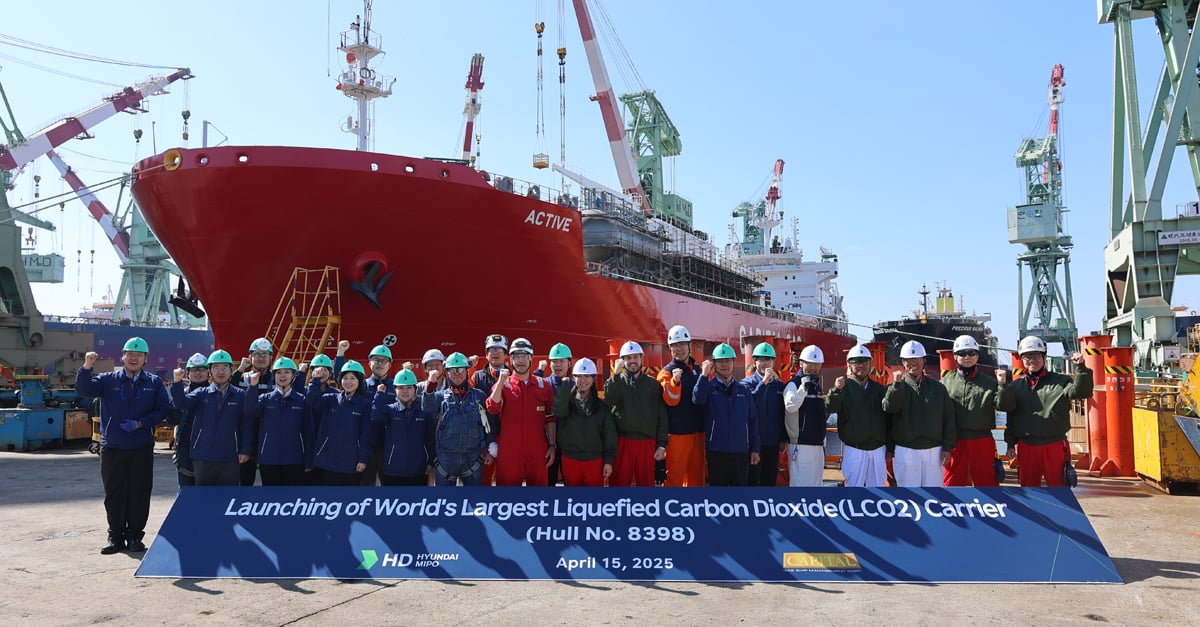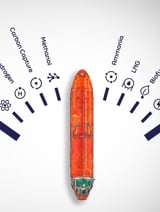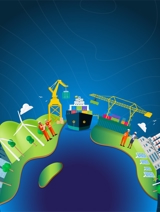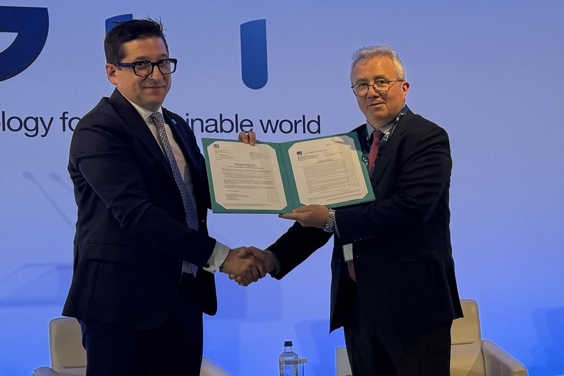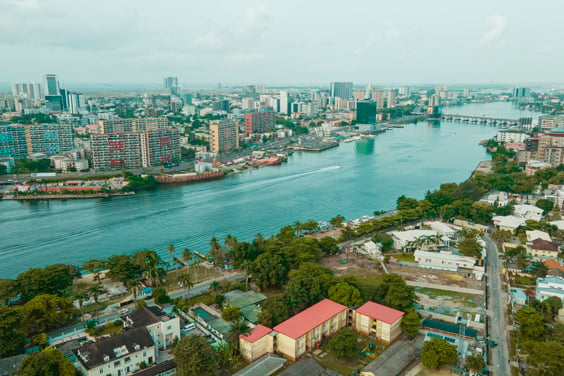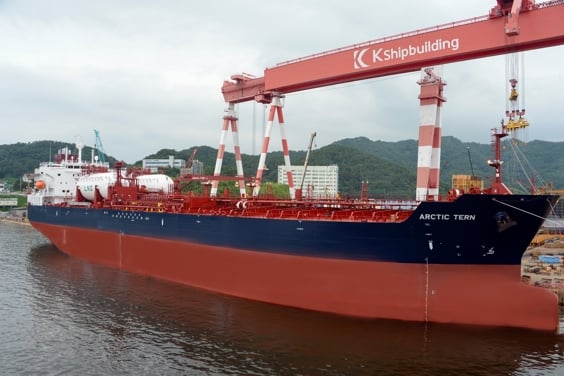LNG is increasingly being used in industry to shore up energy security and support emissions reduction programmes. It emits around 30% less CO₂ than oil and about 45% less than coal, making it an attractive transitional fuel for hard-to-abate industries under pressure to decarbonise.
Whilst natural gas emits less carbon dioxide per unit of energy than coal, petroleum and kerosene it is not carbon free. To mitigate against the release of carbon into the atmosphere when LNG is used to create energy, a growing industry around carbon capture and storage or reuse is emerging. The pressure is now on for industrial sectors to deliver efficient and scalable solutions to transport the captured carbon.
Here the maritime industry can play a role, transporting CO₂ in its liquid form (LCO₂) and providing a vital link in the carbon capture, usage and storage (CCUS) chain.
US-listed Capital Clean Energy Carriers ordered four ammonia-ready LCO₂ low-pressure (LP) LCO₂ carriers in July 2023, to be built at HD Korea Shipbuilding & Offshore Engineering’s (HD KSOE) HD Hyundai Mipo, all classed by LR. The first of the four 22,000 cbm vessels was floated out in April this year (2025).
The event marks a significant breakthrough in carbon shipping technology, as the low-pressure vessel, the first of its kind, offers significantly enhanced cargo capacity, cost-efficiency and operational reliability. This serves as a core value proposition where carbon avoidance is traditionally associated only with added cost.
It also represents a break-through for the LCO₂ supply chain in general, believes LR’s Global Gas Segment Director, Pano Mitrou. All projections point to CO₂ capture as an important component in achieving net-zero by 2050, he tells Horizons. The maritime supply chain for the cargo will need to evolve to accommodate the anticipated demand in trade, he says, and move from an A to B trade to a live and flexible trade. “This will enable a globally unified, standardised and healthy LCO₂ trade within shipping,” he asserts, “that can grow and be flexible to market requirements.”
Engineering cargo space
The very limited number of LCO₂ ships currently trading LCO₂ use medium-pressure (MP) systems, operating at higher pressures (19 bar) and higher temperatures (-35°C). HD Hyundai Mipo’s Executive Vice President, Dongjin Lee, explains: “While technically sound, these systems are constrained by limitations in spatial efficiency and higher costs associated with materials, especially for large-scale transport needs from the CCS industry”.
In contrast, LP LCO₂ cargo tanks are designed to operate at around 8 bar and at a colder temperature of -55°C.
Initially, HD KSOE developed an Engineering Critical Assessment (ECA) methodology for LCO₂ tanks, in accordance with the IGC Code (International Code of the Construction and Equipment of Ships Carrying Liquefied Gases in Bulk), IACS (International Association of Class Societies) Rules and BS (British Standard) 7910 guidelines, obtaining certification from major class societies. Further, with the material properties, structural integrity verification and AiP (Approval in Principle) from LR for the 22,000 LPLCO₂ tanks have been achieved based on the ECA methodology.
The tanks utilise thermo-mechanically controlled process (TMCP) low-temperature steel that is highly crack resistant, enabling maximum storage efficiency, Dongju Lee, Vice President, KSOE, says. After the tanks’ fabrication and welding, the tanks were subjected to Post Weld Heat Treatment (PWHT).
The LP design also allows for a special tank design (bi-lobe), which overlaps two cylindrical tanks into a single integrated structure, significantly improving cargo intake efficiency. This tank configuration would be structurally challenging on a medium-pressure vessel due to the higher stress concentrations, but under LP conditions is feasible and safe.
“For instance, assuming an equivalent tank length of approximately 40 meters, the LP tank constructed with TMCP steel enables approximately 1.7 times greater LCO2 storage capacity compared to a medium-pressure (MP) tank design.” Dongju Lee says.
Reduced costs, increased efficiency
Meanwhile, the new tank type offers further costs savings. LR’s Global Gas Technology Director Jose Navarro noted that higher-pressure tanks are significantly more expensive to build due to the need for thicker, heavier materials. “These tanks increase the vessel's weight, leading to higher capital and operational expenditures. They are also smaller, so more tanks are required to carry the same volume of LCO₂, raising costs further due to the need for more instrumentation and cargo handling systems,” he notes.
The four vessels are being built in preparation for the nascent CO₂ chain to develop. In the interim period the vessels are also capable of transporting LPG and ammonia. This flexibility enhances their commercial viability by allowing operators to switch between cargoes based on market demand.
The vessels are also able to carry two different types of cargo at the same time, further enhancing their commercial appeal.
Here Navarro emphasises the importance of installing a sophisticated multifunctional cargo handling system (CHS). “The CHS being installed on the vessels is designed by Babcock LGE, to safely and efficiently manage a diverse range of cargoes, including more hazardous ones like ammonia,” he notes.
“All the relevant design and safety features across the ship's infrastructure have been incorporated so that it is safe to handle more toxic cargoes like ammonia, for high standards of operational safety across all cargoes,” comments Navarro.
Dr. Youngjae Sung, Vice President of HD KSOE, explains that HD KSOE successfully completed a CO₂ cargo operation test for the company’s low-pressure design. "All possible CO₂ cargo operation scenarios were simulated at HD KSOE’s Marine Innovative Decarbonization R&D Facility. The test results clearly validate that CO₂ cargo can be handled safely and efficiently under real ship operation conditions," he states.
Mitrou believes that at 22,000 cbm and with multi-gas capabilities, the vessels will be versatile assets within Capital Clean Energy Carriers’ fleet.
“This low-pressure design is the most optimal solution available today,” he says, reiterating Dongju Lee’s comment about cargo capacity. “This, combined with their dimensions makes them ideal for shorter coastal operations, as well as long-haul voyages,” he notes, adding that they will not be locked in a single market. “This project is a first for all partners involved and for our industry,” he asserts, “and puts Capital ahead in the CO₂ transport market.”
Miltos Zisis, Managing Director, Capital Gas Ship Management Corp agrees. Commenting that their proactive stance will set new standards for the industry, he says, “We see significant opportunity in the emerging carbon capture, storage and re-use market and expect demand to increase in the near future. Our investment in these vessels will support the decarbonisation of hard-to-abate industries with cost efficient transport solutions, including maritime, whilst supporting Capital Clean Energy Carriers’ strategic vision of maintaining a commercially relevant and sustainable fleet for the years to come.”
The four vessels are expected to be first movers in a new, flexible and standardised LCO₂ shipping sector that will be support the energy transition and industry’s efforts to reach net-zero.
